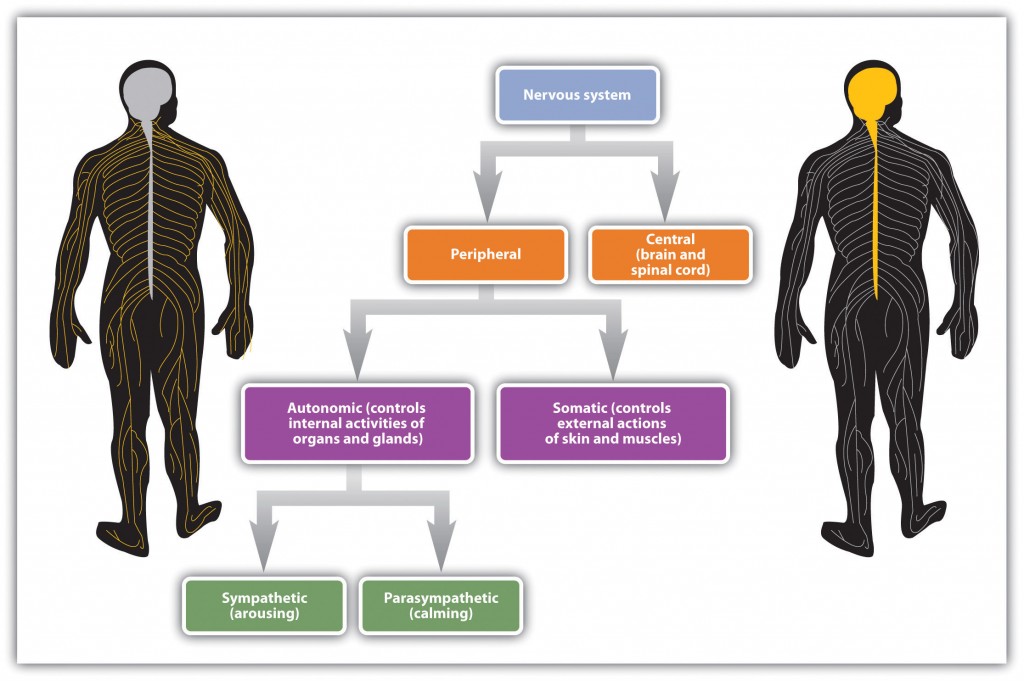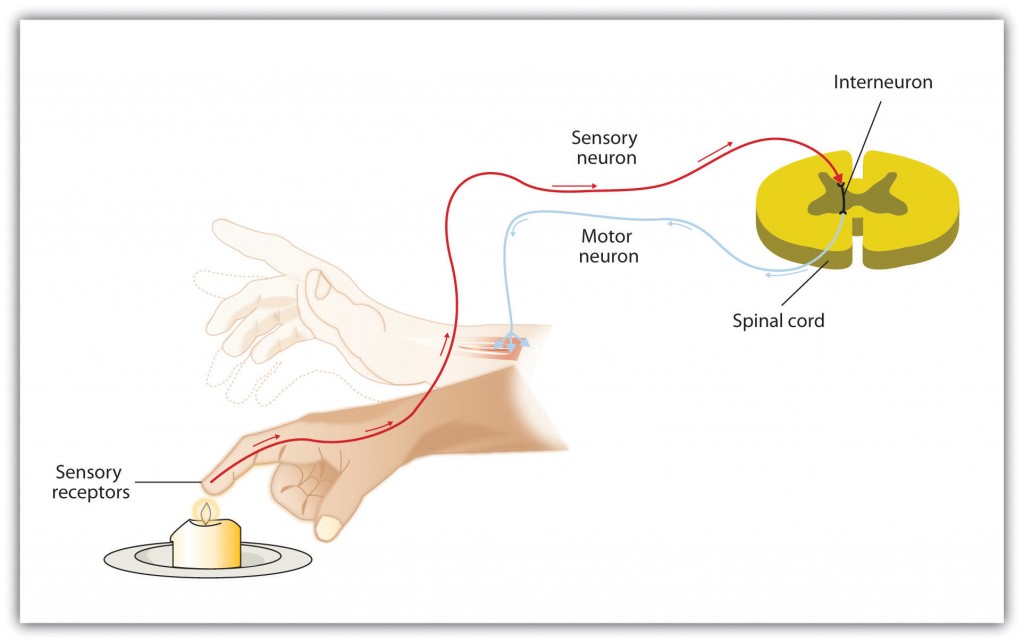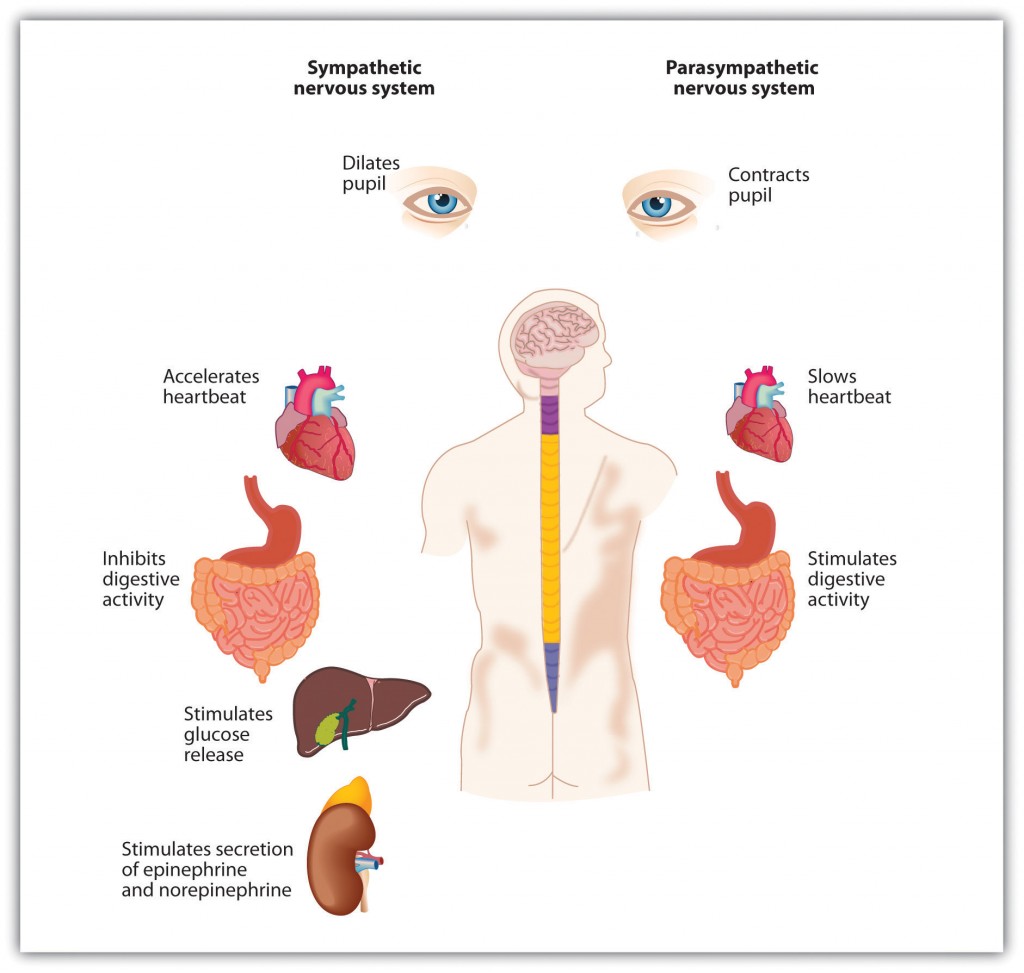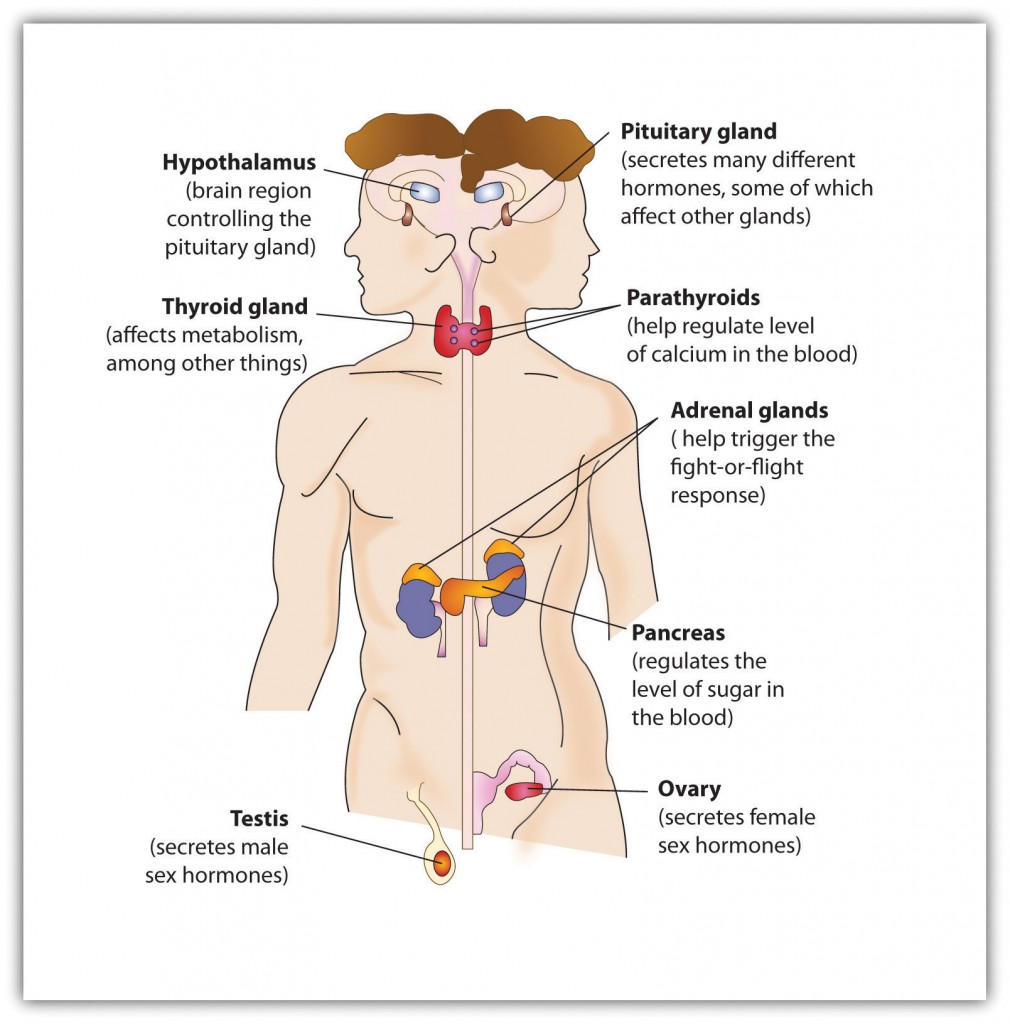Homeostasis and Endocrine System Active Reading Guide
Chapter 4. Brains, Bodies, and Behaviour
4.4 Putting It All Together: The Nervous System and the Endocrine System
Learning Objectives
- Summarize the main functions of the CNS and of the subsystems of the PNS.
- Explain how the electrical components of the nervous arrangement and the chemic components of the endocrine system work together to influence behaviour.
Now that nosotros take considered how individual neurons operate and the roles of the different brain areas, it is time to ask how the torso manages to put it all together. How do the complex activities in the various parts of the brain, the simple all-or-nothing firings of billions of interconnected neurons, and the various chemical systems within the body work together to permit the trunk to reply to the social environment and engage in everyday behaviours? In this section we will see that the complexities of human behaviour are accomplished through the articulation actions of electrical and chemic processes in the nervous arrangement and the endocrine system.
Electrical Command of Behaviour: The Nervous Organization
The nervous system (run into Figure four.16, "The Functional Divisions of the Nervous Organisation"), the electrical data highway of the body, is made up of nerves — bundles of interconnected neurons that burn in synchrony to deport messages. The fundamental nervous system (CNS), made up of the encephalon and spinal cord, is the major controller of the body's functions, charged with interpreting sensory information and responding to it with its ain directives. The CNS interprets data coming in from the senses, formulates an advisable reaction, and sends responses to the appropriate system to respond accordingly. Everything that we come across, hear, odour, touch on, and taste is conveyed to us from our sensory organs as neural impulses, and each of the commands that the brain sends to the body, both consciously and unconsciously, travels through this system too.

Fretfulness are differentiated according to their function. A sensory (or afferent) neuroncarries information from the sensory receptors, whereas a motor (or efferent) neurontransmits information to the muscles and glands. An interneuron, which is by far the nigh common blazon of neuron, is located primarily within the CNS and is responsible for communicating among the neurons. Interneurons allow the brain to combine the multiple sources of available data to create a coherent picture of the sensory information being conveyed.
The spinal cord is the long, thin, tubular parcel of fretfulness and supporting cells that extends down from the brain. It is the central throughway of information for the body. Inside the spinal cord, ascending tracts of sensory neurons relay sensory information from the sense organs to the brain while descending tracts of motor neurons relay motor commands back to the body. When a quicker-than-usual response is required, the spinal string can do its own processing, bypassing the brain altogether. A reflex is an involuntary and nearly instantaneous motility in response to a stimulus. Reflexes are triggered when sensory information is powerful enough to reach a given threshold and the interneurons in the spinal cord human action to send a bulletin back through the motor neurons without relaying the information to the brain (see Figure 4.17, "The Reflex"). When you lot touch a hot stove and immediately pull your paw dorsum, or when you fumble your cell telephone and instinctively achieve to catch information technology earlier it falls, reflexes in your spinal cord order the appropriate responses before your encephalon even knows what is happening.

If the cardinal nervous system is the command heart of the body, the peripheral nervous system (PNS) represents the front end line. The PNS links the CNS to the torso's sense receptors, muscles, and glands. As yous can encounter in Figure 4.18, "The Autonomic Nervous Organization," the peripheral nervous system is itself divided into 2 subsystems, ane controlling internal responses and one decision-making external responses.
The autonomic nervous organization (ANS) is the sectionalization of the PNS that governs the internal activities of the man body, including middle rate, animate, digestion, salivation, perspiration, urination, and sexual arousal. Many of the deportment of the ANS, such as heart rate and digestion, are automatic and out of our conscious command, but others, such equally breathing and sexual action, can exist controlled and influenced by witting processes.
The somatic nervous organization (SNS) is the division of the PNS that controls the external aspects of the body, including the skeletal muscles, skin, and sense organs. The somatic nervous organization consists primarily of motor fretfulness responsible for sending brain signals for musculus contraction.
The autonomic nervous organisation itself can be further subdivided into the sympathetic and parasympathetic systems. The sympathetic division of the ANS is involved in preparing the trunk for behaviour, particularly in response to stress, past activating the organs and the glands in the endocrine system. The parasympathetic division of the ANStends to calm the body by slowing the heart and animate and by allowing the body to recover from the activities that the sympathetic arrangement causes. The sympathetic and the parasympathetic divisions normally role in opposition to each other, with the sympathetic division acting a bit like the accelerator pedal on a auto and the parasympathetic division acting like the brake.

Our everyday activities are controlled by the interaction between the sympathetic and parasympathetic nervous systems. For instance, when we get out of bed in the morning, we would experience a sharp drop in blood pressure level if it were not for the action of the sympathetic organisation, which automatically increases blood flow through the body. Similarly, later on we eat a big meal, the parasympathetic organisation automatically sends more blood to the stomach and intestines, assuasive us to efficiently digest the food. And maybe you have had the experience of not being at all hungry before a stressful effect, such as a sports game or an exam (when the sympathetic partition was primarily in action), but suddenly finding yourself feeling starved afterwards, as the parasympathetic takes over. The two systems work together to maintain vital actual functions, resulting in homeostasis, the natural residual in the body'southward systems.
The Trunk'south Chemicals Help Control Behaviour: The Endocrine System
The nervous organisation is designed to protect us from danger through its interpretation of and reactions to stimuli. Simply a master role of the sympathetic and parasympathetic nervous systems is to interact with the endocrine system to arm-twist chemicals that provide another arrangement for influencing our feelings and behaviours.
A gland in the endocrine system is made up of groups of cells that office to secrete hormones. A hormone is a chemical that moves throughout the trunk to help regulate emotions and behaviours. When the hormones released by one gland go far at receptor tissues or other glands, these receiving receptors may trigger the release of other hormones, resulting in a series of complex chemic chain reactions. The endocrine system works together with the nervous organisation to influence many aspects of human behaviour, including growth, reproduction, and metabolism. And the endocrine organization plays a vital part in emotions. Because the glands in men and women differ, hormones also assist explain some of the observed behavioural differences between men and women. The major glands in the endocrine system are shown in Figure 4.xix, "The Major Glands of the Endocrine System."

The pituitary gland, a small pea-sized gland located most the centre of the encephalon, is responsible for controlling the body'southward growth, just it too has many other influences that brand it of chief importance to regulating behaviour. The pituitary secretes hormones that influence our responses to hurting too as hormones that signal the ovaries and testes to make sex hormones. The pituitary gland also controls ovulation and the menstrual bicycle in women. Because the pituitary has such an of import influence on other glands, information technology is sometimes known equally the "master gland."
Other glands in the endocrine organisation include the pancreas, which secretes hormones designed to go on the body supplied with fuel to produce and maintain stores of energy; the pineal gland, located in the eye of the brain, which secretes melatonin, a hormone that helps regulate the wake-sleep cycle; and the thyroid and parathyroid glands, which are responsible for determining how quickly the body uses free energy and hormones, and controlling the corporeality of calcium in the claret and bones.
The body has two triangular adrenal glands, one atop each kidney. The adrenal glandsproduce hormones that regulate salt and h2o balance in the torso, and they are involved in metabolism, the immune system, and sexual development and function. The most important function of the adrenal glands is to secrete the hormones epinephrine (also known as adrenaline) and norepinephrine (also known as noradrenaline) when we are excited, threatened, or stressed. Epinephrine and norepinephrine stimulate the sympathetic partitioning of the ANS, causing increased centre and lung activity, dilation of the pupils, and increases in blood sugar, which give the body a surge of free energy to respond to a threat. The activity and role of the adrenal glands in response to stress provide an excellent example of the shut relationship and interdependency of the nervous and endocrine systems. A quick-interim nervous organisation is essential for firsthand activation of the adrenal glands, while the endocrine system mobilizes the body for action.
The male person sex glands, known every bit the testes, secrete a number of hormones, the near of import of which is testosterone, the male sex hormone. Testosterone regulates body changes associated with sexual development, including enlargement of the penis, deepening of the voice, growth of facial and pubic hair, and the increase in muscle growth and force. The ovaries, the female sex glands, are located in the pelvis. They produce eggs and secrete the female hormones estrogen and progesterone. Estrogen is involved in the evolution of female person sexual features, including chest growth, the accumulation of body fat around the hips and thighs, and the growth spurt that occurs during puberty. Both estrogen and progesterone are also involved in pregnancy and the regulation of the menstrual cycle.
Contempo enquiry has pinpointed some of the important roles of the sex hormones in social behaviour. Dabbs, Hargrove, and Heusel (1996) measured the testosterone levels of 240 men who were members of 12 fraternities at two universities. They also obtained descriptions of the fraternities from university officials, fraternity officers, yearbook and chapter house photographs, and researcher field notes. The researchers correlated the testosterone levels and the descriptions of each fraternity. They found that the fraternities with the highest boilerplate testosterone levels were also more wild and unruly, and ane of these fraternities was known across campus for the crudeness of its behaviour. On the other hand, the fraternities with the lowest average testosterone levels were more than well behaved, friendly and pleasant, academically successful, and socially responsible. Banks and Dabbs (1996) found that juvenile delinquents and prisoners who had high levels of testosterone also acted more violently, and Tremblay and colleagues (1998) found that testosterone was related to toughness and leadership behaviours in adolescent boys. Although testosterone levels are college in men than in women, the relationship between testosterone and aggression is non limited to males. Studies have as well shown a positive relationship between testosterone and aggression and related behaviours (such equally competitiveness) in women (Cashdan, 2003).
Go along in mind that the observed relationships between testosterone levels and aggressive behaviour that accept been found in these studies practise non testify that testosterone causes aggression — the relationships are only correlational. In fact, there is bear witness that the relationship between violence and testosterone also goes in the other management: playing an ambitious game, such equally tennis or even chess, increases the testosterone levels of the winners and decreases the testosterone levels of losers (Gladue, Boechler, & McCaul, 1989; Mazur, Booth, & Dabbs, 1992), and perhaps this is why excited soccer fans sometimes riot when their squad wins.
Recent research has also begun to document the office that female sex hormones may play in reactions to others. A study well-nigh hormonal influences on social-cerebral functioning (Macrae, Alnwick, Milne, & Schloerscheidt, 2002) found that women were more hands able to perceive and categorize male faces during the more fertile phases of their menstrual cycles. Although researchers did not directly measure the presence of hormones, it is likely that phase-specific hormonal differences influenced the women's perceptions.
At this betoken yous can brainstorm to see the important function the hormones play in behaviour. But the hormones we take reviewed in this section correspond only a subset of the many influences that hormones accept on our behaviours. In the chapters to come up we will consider the important roles that hormones play in many other behaviours, including sleeping, sexual practice, and helping and harming others.
Key Takeaways
- The body uses both electrical and chemical systems to create homeostasis.
- The CNS is made upwardly of bundles of nerves that comport letters to and from the PNS.
- The peripheral nervous system is composed of the autonomic nervous arrangement (ANS) and the peripheral nervous organization (PNS). The ANS is further divided into the sympathetic (activating) and parasympathetic (calming) nervous systems. These divisions are activated by glands and organs in the endocrine organisation.
- Specific nerves, including sensory neurons, motor neurons, and interneurons, each accept specific functions.
- The spinal cord may featherbed the brain by responding rapidly using reflexes.
- The pituitary gland is a principal gland, affecting many other glands.
- Hormones produced by the pituitary and adrenal glands regulate growth, stress, sexual functions, and chemic residual in the body.
- The adrenal glands produce epinephrine and norepinephrine, the hormones responsible for our reactions to stress.
- The sexual activity hormones, testosterone, estrogen, and progesterone, play an important part in sexual practice differences.
Exercises and Critical Thinking
- Recall a time when you were threatened or stressed. What physiological reactions did yous experience in the situation, and what aspects of the endocrine system do you call up created those reactions?
- Consider the emotions that you have experienced over the past several weeks. What hormones do you call up might accept been involved in creating those emotions?
References
Banks, T., & Dabbs, J. Thousand., Jr. (1996). Salivary testosterone and cortisol in delinquent and trigger-happy urban subculture.Journal of Social Psychology, 136(1), 49–56.
Cashdan, E. (2003). Hormones and competitive aggression in women.Aggressive Behavior, 29(ii), 107–115.
Dabbs, J. M., Jr., Hargrove, M. F., & Heusel, C. (1996). Testosterone differences amongst college fraternities: Well-behaved vs. rambunctious.Personality and Individual Differences, 20(2), 157–161.
Gladue, B. A., Boechler, M., & McCaul, K. D. (1989). Hormonal response to competition in human males.Aggressive Beliefs, 15(vi), 409–422.
Macrae, C. N., Alnwick, M. A., Milne, A. B., & Schloerscheidt, A. One thousand. (2002). Person perception across the menstrual cycle: Hormonal influences on social-cerebral functioning.Psychological Science, 13(vi), 532–536.
Mazur, A., Berth, A., & Dabbs, J. M. (1992). Testosterone and chess contest.Social Psychology Quarterly, 55(i), seventy–77.
Tremblay, R. E., Schaal, B., Boulerice, B., Arseneault, L., Soussignan, R. M., Paquette, D., & Laurent, D. (1998). Testosterone, physical aggression, potency, and physical development in early on adolescence.International Journal of Behavioral Development, 22(4), 753–777.
Long Descriptions
Figure iv.16 long description: The nervous system is fabricated up of two parts: The central nervous system consisting of the encephalon and spinal cord and the peripheral nervous arrangement. The peripheral nervous system is both autonomic (controlling internal activities of organs and glands) and somatic (controlling external deportment of skin and muscles). [Return to Effigy iv.16]
| Sympathetic Nervous Arrangement | Parasympathetic Nervous System |
|---|---|
| Dilates pupil | Contracts educatee |
| Accelerates heartbeat | Slows heartbeat |
| Inhibits digestive activity | Stimulates digestive activity |
| Stimulates glucose release | |
| Stimulates secretion of epinephrine and norepinephrine |
[Return to Figure four.18]
Source: https://opentextbc.ca/introductiontopsychology/chapter/3-4-putting-it-all-together-the-nervous-system-and-the-endocrine-system/
إرسال تعليق for "Homeostasis and Endocrine System Active Reading Guide"